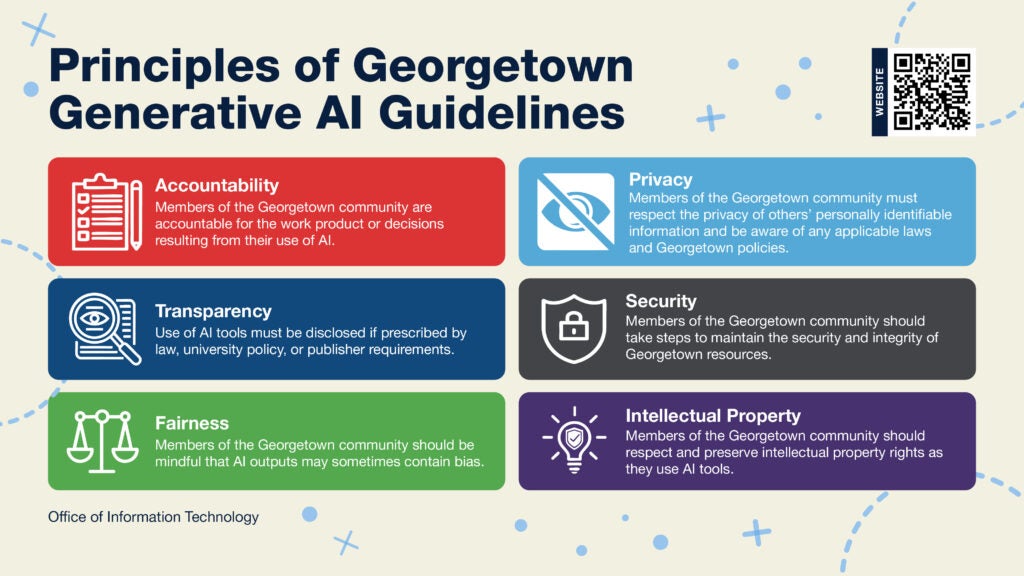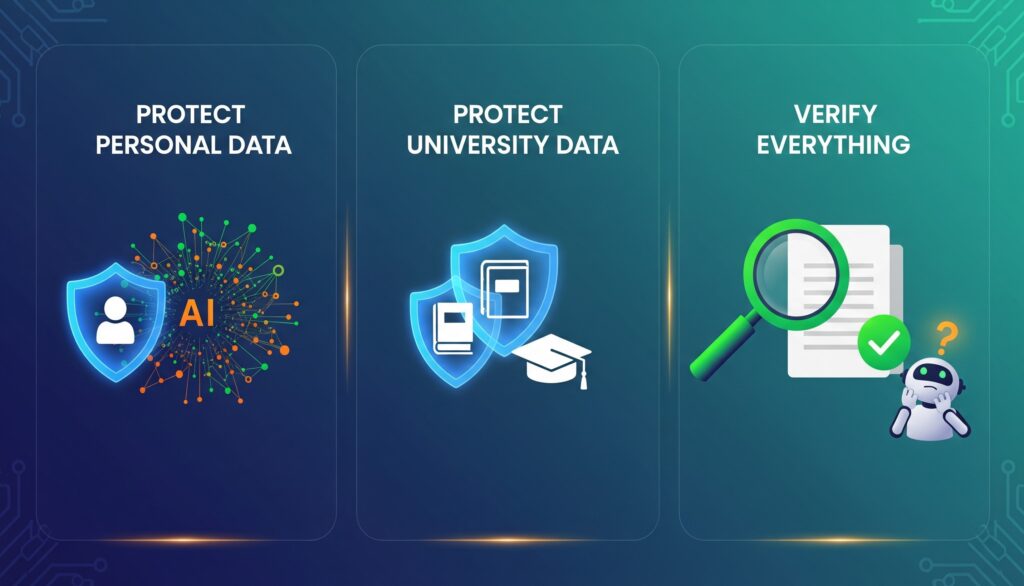Artificial Intelligence (AI)
AI Guidelines at Georgetown University
The use of generative AI at Georgetown University is guided by a set of core principles that align with the institution’s values and existing policies. These guidelines emphasize the responsible use of AI for all members of the community, including staff, students, and faculty.
Also take a look at a short video preview ‘created by AI’ of the university AI guidelines here.
Key Guiding Principles:
- Accountability: All members of the Georgetown community are accountable for the work and decisions that result from their use of AI tools.
- Transparency: You must disclose the use of AI tools if required by law, university policy, or publisher requirements.
- Fairness: Be aware that AI outputs can sometimes contain bias.
- Privacy: Respect the privacy of others’ personally identifiable information and be mindful of applicable laws and Georgetown policies.
- Security: Take steps to maintain the security and integrity of Georgetown’s resources.
- Intellectual Property & Confidentiality: Respect and preserve intellectual property rights when using AI tools.

How do you make good use of AI but “wisely and safely”?
- Do not allow unfamiliar bots to attend meetings.
- Protect your Personal Data by never entering your own data or anyone else’s sensitive personal information into a public AI tool, as these tools learn new data from our interactions.
- Protect the University Data by not inputting any non-public university information, such as research data, internal documents, or other confidential materials, in an unapproved AI tool that is not under an enterprise-wide contract.
- Verify Everything: AI can sometimes make mistakes, also known as Hallucinations. Always double-check facts, figures, and citations it gives you with reliable sources.

AI Tools
Please note that while there may be no explicit charge for use of software or an application, vendors usually require an End User License Agreement which is not usually tailored for the higher education environment. For example, “FERPA and GDPR” are not typically addressed in an End User License Agreement. Most tools will also have Terms of Use. These are usually very favorable to the company providing the tool and not necessarily favorable to you as an individual and to Georgetown University. If you are using an AI tool, for a Georgetown matter, that has not yet been approved, you should contact IT User Support at guqhelpcenter@georgetown.edu to ensure that any necessary terms of use are protective of and acceptable to the university.
Zoom AI Companion “meeting note taker” has been reviewed and approved by the university.
Crafting Your Prompts
The Four Key Components:
When writing an effective prompt, there are four main areas to consider. You don’t need to use all of them in every prompt, but including a few will help you get better results. The most important component is the task, which should always include a verb or a command.
- Persona: Define the role you want the tool to adopt (e.g., “You are a program manager…”).
- Task: State what you need the tool to do (e.g., “Draft an executive summary…”).
- Context: Provide relevant details and information (e.g., “…based on [details about relevant program docs]”).
- Format: Specify how you want the output to be structured (e.g., “Limit to bullet points.”).

Quick Tips for Effective Prompting:
- Use natural language: Write in full sentences as if you’re talking to a person.
- Be specific and iterate: Tell teh tool what you need it to do (e.g., summarize, write, change the tone, create) and provide as much context as possible. If the initial result isn’t what you expected, fine-tune your prompts and continue the conversation.
- Keep it concise: Use brief but specific language and avoid jargon.
- Reference your documents: Personalize tool’s output by referencing your own files in Google Drive. Just type “@” followed by the file name.
Important Reminder:
While generative AI is an exciting tool, its responses can sometimes be unpredictable. Always review the output for clarity, relevance, and accuracy before using it. Remember, these are simplya tools to help humans, but the final output is yours.